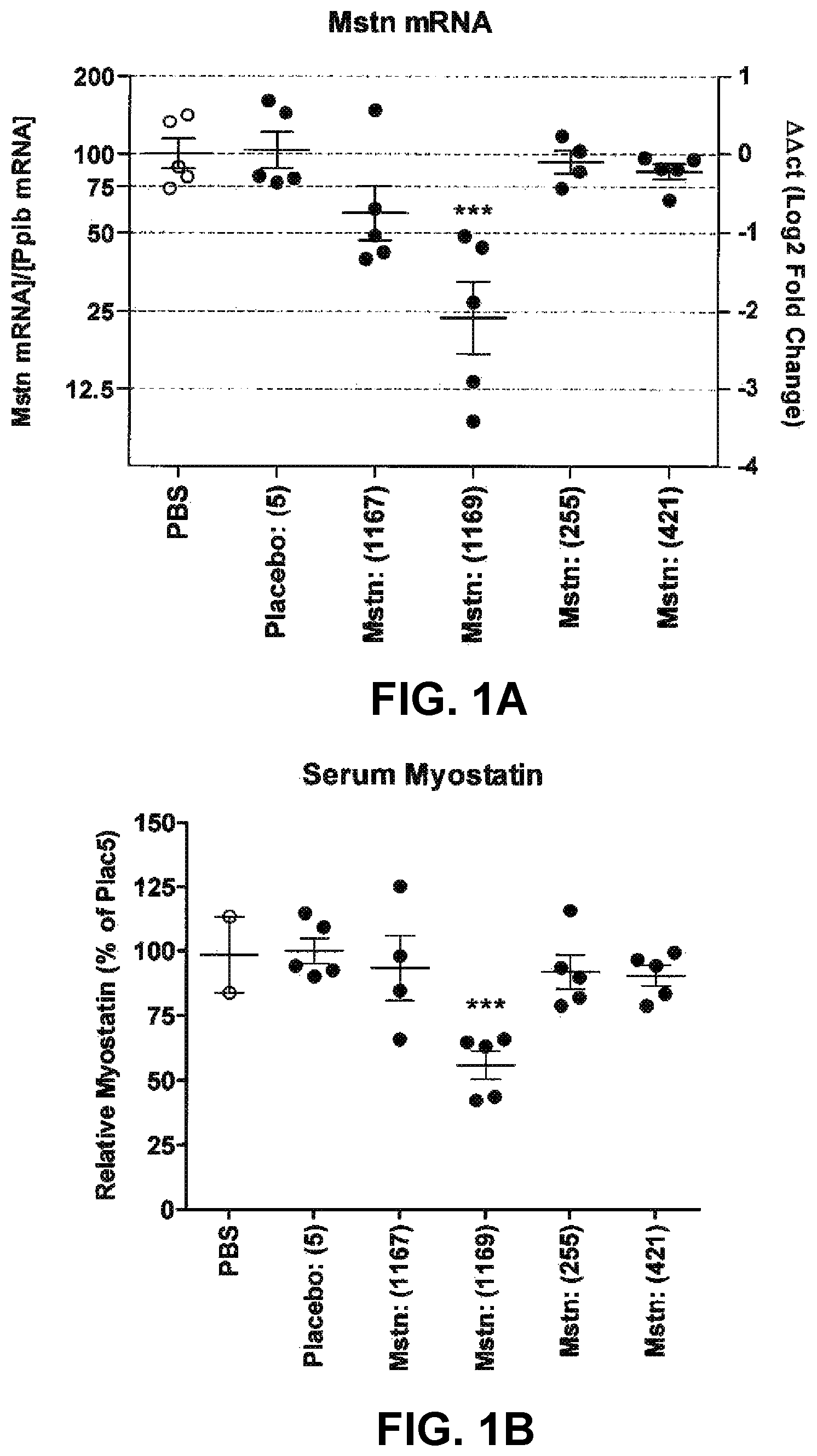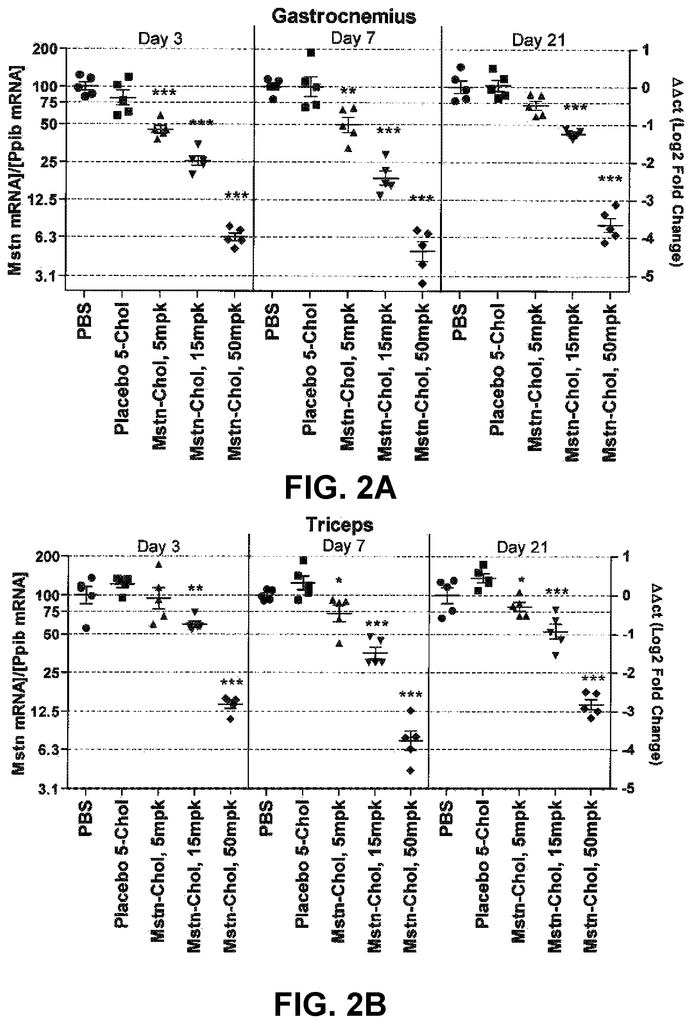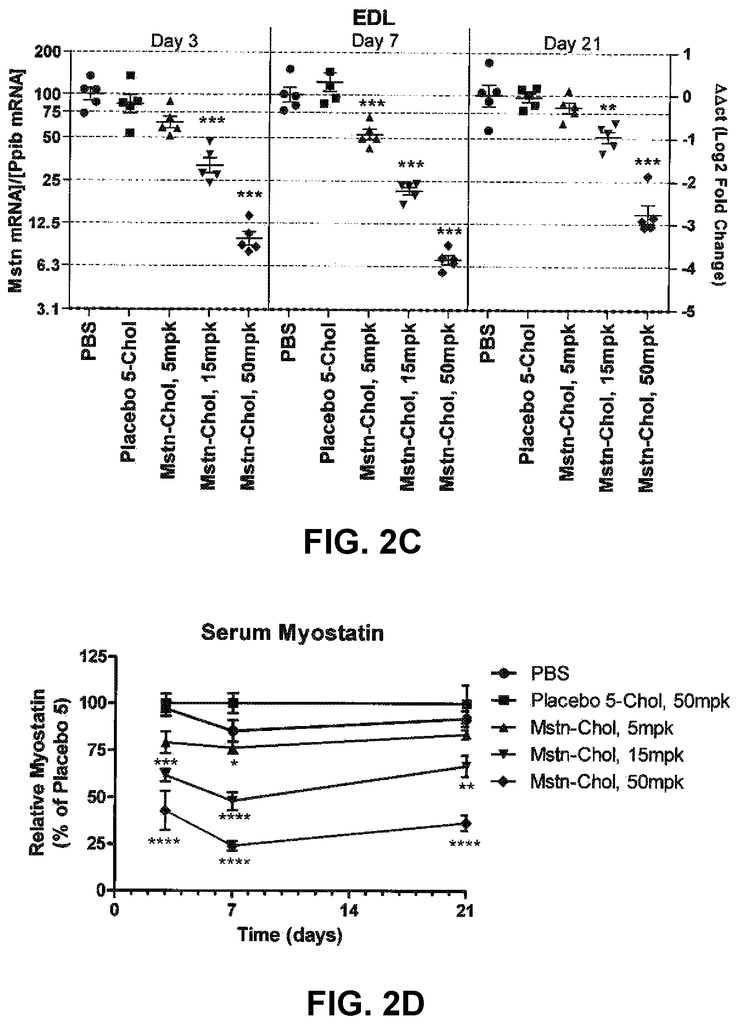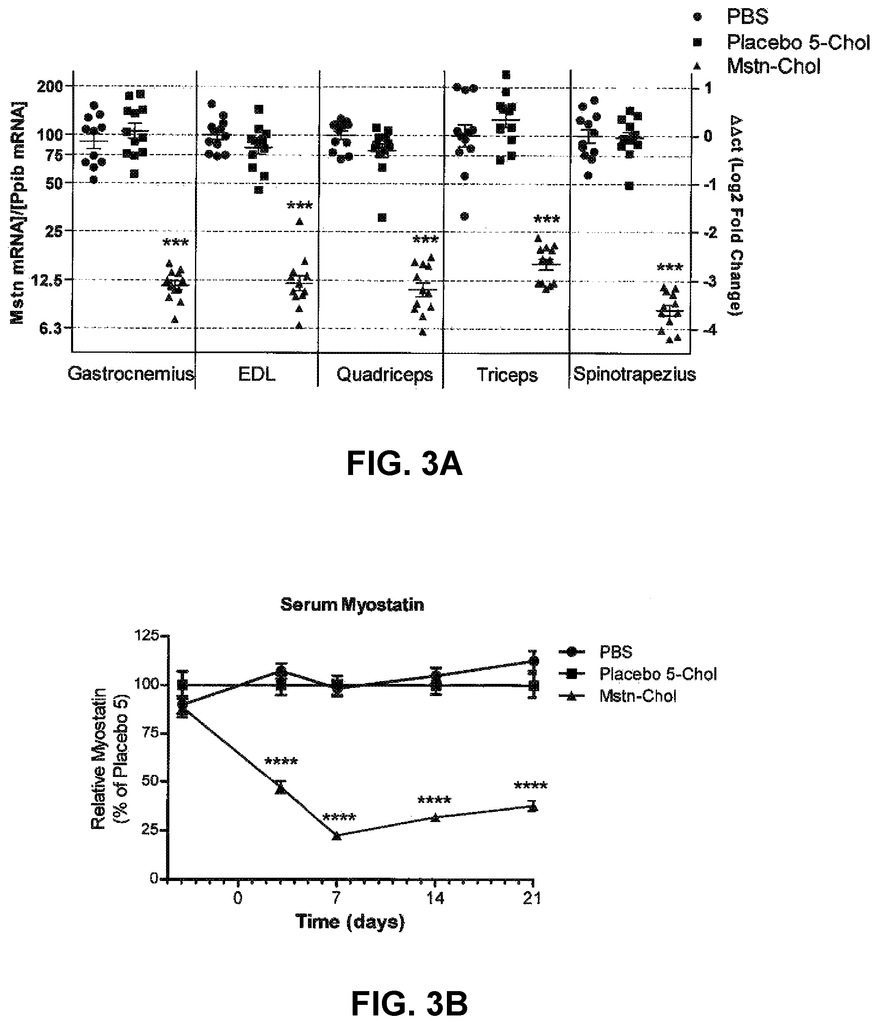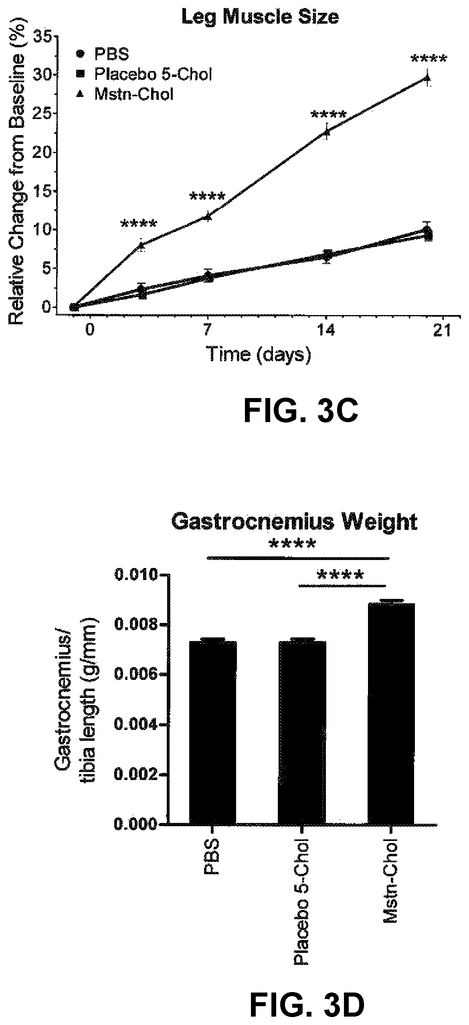Invented by Marija Tadin-Strapps, Tayeba Khan, Walter Richard Strapps, Laura Sepp-Lorenzino, Vasant R. Jadhav, Duncan Brown, Sirna Therapeutics Inc, Merck Sharp and Dohme LLC
The systemic delivery of siNA, conjugated to a lipid moiety, offers several advantages over other delivery methods. Lipid conjugation enhances the stability and cellular uptake of siNA, allowing for efficient delivery to target tissues. This approach also enables systemic administration, meaning the siNA can be delivered throughout the body, reaching muscle tissues that are difficult to access using other delivery methods.
One of the key drivers for the market growth is the increasing prevalence of muscle-related disorders, such as muscular dystrophy and sarcopenia. These conditions result in muscle wasting and weakness, leading to significant morbidity and reduced quality of life. The ability to selectively inhibit myostatin expression using siNA holds great potential for treating these disorders and improving muscle function.
Another factor contributing to the market growth is the growing interest from pharmaceutical companies and biotechnology firms. Several companies have already entered the race to develop siNA-based therapies for muscle-related disorders. These companies are investing heavily in research and development to optimize the delivery and efficacy of siNA conjugated to a lipid moiety. The market competition is expected to drive innovation and accelerate the development of novel therapies.
Furthermore, advancements in nucleic acid delivery technologies are also fueling the market growth. Researchers are continuously exploring new strategies to improve the delivery efficiency and safety of siNA-based therapies. This includes the development of novel lipid conjugates, nanoparticle-based delivery systems, and targeted delivery approaches. These advancements are expected to overcome the existing challenges associated with systemic delivery of siNA and further expand the market potential.
However, there are still some challenges that need to be addressed for the widespread adoption of systemic delivery of myostatin siNA. One of the major challenges is the safety profile of siNA-based therapies. Although siNA has shown promising results in preclinical studies, concerns regarding off-target effects and immune responses need to be carefully evaluated in clinical trials. Additionally, the high cost of development and manufacturing of siNA-based therapies may pose a barrier to market growth.
In conclusion, the market for systemic delivery of myostatin siNA, conjugated to a lipid moiety, is expected to witness significant growth in the coming years. The increasing prevalence of muscle-related disorders, growing interest from pharmaceutical companies, and advancements in nucleic acid delivery technologies are driving the market expansion. However, addressing safety concerns and reducing the cost of development are crucial for the successful commercialization of siNA-based therapies. With continued research and development efforts, siNA-based therapies have the potential to revolutionize the treatment of muscle-related disorders and improve the lives of millions of patients worldwide.
The Sirna Therapeutics Inc, Merck Sharp and Dohme LLC invention works as follows
The present invention provides a method of delivering small nucleic acids to a patient by systemic administration. These small nucleic acids are capable of mediating the RNA interference, and can reduce the expression of myostatin. The invention is a method of in vivo delivery that involves short interfering (siNA), which targets a myostatin expressed by a patient, conjugated with a lipophilic moiety such as cholesterol. The methods that deliver myostatin conjugates are useful for modulating the in vivo myostatin expression, increasing muscle mass and/or enhancing muscle performance. The disclosed methods are also indicated to treat musculoskeletal disorders or diseases, or diseases that lead to conditions where muscle is negatively affected.
Background for Systemic delivery myostatin short-interfering nucleic acid (siNA), conjugated to a lipid moiety
RNA interference (RNAi), an evolutionarily preserved cellular mechanism for post-transcriptional silencing of genes, is found in fungi and plants. It uses small RNA molecules that inhibit gene expression by a specific sequence. RNAi is controlled via the RNA-induced Silencing Complex (RISC), which is triggered by double-stranded RNA in a cell’s cytoplasm. The short double-stranded RNA binds to Argonaute 2(Ago2) which is the catalytic component in RISC. This cleaves the complementary mRNA of the bound RNA. The guide strand of RNA binds to the Ago2 and silences genes, while the passenger strand is degraded by RISC activation. For example, Zamore, Haley and Vaughn, 2005 in Science 309, 1519-1524, Vaughn, Martienssen and Bass, 2005 in Science 309, 1525-1526, Zamore, Elbashir and others, 2000 Cell 101, 25-33, Bass, 2001 Nature 411, 428-429, and Elbashir and colleagues, 2001 Nature 411, 494-498. “Single-stranded interfering short RNA also binds Ago2 to support cleavage (see, for example, Lima and al., 2012 Cell 150:883-894).
The RNAi machine can be used to destroy mRNAs of a specific sequence. This allows the suppression (knockdown), of any gene that was derived from it, thereby preventing the synthesis the target protein. The RNAi method can be used to modulate biochemical pathways that are therapeutically important, even those not accessible by traditional small molecule control.
Chemical modification of nucleotides incorporated in RNAi molecules results in improved physical and biologic properties, including nuclease stabilization (see e.g. Damha et. al. 2008, Drug Discovery Today 13:842-855); reduced immune stimulation (see e.g. Sioud 2006, TRENDS In Molecular Medicine 12:167-186); enhanced binding (see e.g. Koller E. et. al. 2006, Nucleic acid Research 34:444444444444444444444444444444444444444444444444444444444444 Chemical modifications can increase the potency of RNA molecules, allowing for lower doses, decreasing the risk of toxicity and lowering the overall cost of treatment.
In recent years, advances made in oligonucleotide designs and chemical modification patterns have led to molecules that are more resistant to nuclease degradation, with improved pharmokinetics and gene specificity, and reduced immune stimulatory responses” (Lares M. R. and co-workers). Trends Biotechnol. 58:570-9). In spite of these major advancements, siRNA delivery in vivo to diverse tissues is still a major challenge. Although siRNA has been delivered in vivo in the eye, lung and brain by localized injections (by intraocular and intranasal intrathecal intratumoral and intramuscular injections), this method of delivery is only appropriate for target validation studies because it is invasive and has limited relevance in clinical therapy. 12:246-51; Liang, Y. et al., 2010, PLoS One 5:e12860; Reich, S. J. et al., 2003, Mol. Vis. 9:210-6; Tan, P. H. et al., 2005, Gene Ther. 12:59-66; Zhang, X. et al., 2004, J. Biol. Chem. 279:10677-84). To reach specific tissues, a good systemic delivery is necessary. Many studies have shown systemic and targeted siRNA delivery in vivo using a variety methods. These include cationic polymers and lipids, cholesterol conjugates and cell-penetrating proteins, recombinant virus vectors, small molecules carriers, and antibody-linked siRNA. Natl. Acad. Sci. USA 105:11915-20; Khoury, M. et al., 2006, Arthritis Rheum. 54:1867-77; Kim, B. et al., 2004, Am. J. Pathol. 165:2177-85; Kondo, E. et al., 2012, Nat. Commun. 3:951; Morrissey, D. V. et al., 2005, Nat. Biotechnol. 23:1002-7; Schiffelers, R. M. et al., 2004, Nucleic Acids Res. 32:e149; Song, E. et al., 2005, Nat. Biotechnol. 23:709-17; Wolfrum, C. S. et al., 2007, Nat. Biotechnol. 25:1149-57). The delivery of systemic siRNA has been limited to certain tissues such as the liver, tumors spleen, and jejunum. Ther. 18:171-80; Chien, P. Y. et al., 2005, Cancer Gene Ther. 12:321-8; Liang, Y. et al., supra; Sorensen, D. R. et al., 2003, J. Mol. Biol. 327:761-6; Tadin-Strapps, M. et al., 2011, J. Lipid Res. 52:1084-97; Wolfrum, C. et al., supra).
Myostatin inhibits skeletal muscle growth and differentiation. It is an inhibitor of the myogenesis during development, but its main role in adulthood is to negatively regulate satellite cell activation. Myostatin belongs to the TGF family. Myostatin is a member of the TGF-? J. Physiol. Cell Physiol. 296:C1248-57; Stitt, T. N. et al., 2004, Mol. Cell 14:395-403). Other mouse models of myostatin inhibitory inhibition and Myostatin knockouts display increased muscle strength/mass, and a reduced/reversed muscle atrophy in different muscle disease model (Akpan I. et.al., 2009, International Journal of Muscle Disease). J. Obes. (Lond) 33:1265-73; Heineke, J. et al., 2010, Circulation 121:419-25; Lin, J. et al., 2002, Biochem. Biophys. Res. Commun. Faseb Journal. 25:1653-63; Zhou, X. et al., 2010, Cell 142:531-43). Small-interfering-RNAs targeting myostatin could have many therapeutic applications for the variety of muscle disorders that exist, including muscular dystrophy and muscular atrophy caused by cachexia-inducing conditions, such as heart disease, cancer, chronic obstructive lung disease, sarcopenia and chronic kidney disease. J. Cancer 126:756-63; Bailey, J. L. et al., 2006, J. Am. Soc. Nephrol. 17:1388-94; Engelen, M. P. et al., 1994, Eur. Respir. J. 7:1793-7; Ruegg, M. A. et al., 2011, Annu. Rev. Pharmacol. Toxicol. 51:373-95).
Today, there has only been limited success with siRNA or antisense-oligonucleotide delivery systemically to the muscle. Most reports highlight muscle targeting through local injection (Gebski B. L. and coworkers, 2003, Human. Mol. Genet. 12:1801-11; Guess, M. G. et al., 2013, Skelet. Muscle 3:19; Laws, N. et al., 2008, J. Appl. Physiol. 105:662-8; Tang, Y. et al., 2012, Mol. Pharmacol. 82:322-32). Several studies used intramuscular injections (IM) in conjunction with electroporation to enhance the transfer of siRNAs and plasmids into muscle cells. (Eefting D. et al. 2007, Hum. Gene Ther. 18:861-9; Golzio, M. et al., 2005, supra; Kishida, T. et al., 2004, J. Gene Med. 6:105-10). IM injections are known to cause pain, muscle damage, and inflammation. This limits their use for therapeutic purposes (McMahon J.M. et.al., 1998, Gene Ther. 5:1283-90). A model of ‘local’ delivery can be used to improve IM. A venous muscle delivery system was developed. This involves using a tourniquet in order to temporarily isolate the injection in the muscle. Hydrodynamic injection of the luciferase-pDNA vector into muscle in rats, monkeys, and dogs (Hagstrom J. E. Ther. 10:386-98). It was able to deliver the drug into multiple muscle groups of the limb, and multiple doses were possible. However, the delivery efficiency and skill required for injections is low.
Recent studies have shown that atelocollagen/siRNA complexes can be delivered to muscle in a model of Duchenne muscular dystrophy (DMD) both locally and systemically. Recent studies have shown that an atelocollagen/siRNA combination can be delivered to the muscle of a Duchenne muscular Dystrophy model in both a local and a systemic manner. Growth Differ. 53:48-54; Kinouchi, N. et al., 2008, Gene Ther. 15:1126-30).
The need for therapies that deliver nucleic acid to the muscles easily and non-invasively will continue to exist. These therapies could be used in the treatment of various muscle disorders such as muscular dystrophy and muscular atrophic disease.
The present invention provides methods of delivering small nucleic acids to a subject capable of mediating the RNA interference and decreasing expression of myostatin. Short interfering nucleic acids (siNA) are the small nucleic acids of the invention. The siNA molecules delivered according to the disclosed methods target a myostatin and are conjugated with a lipophilic molecule, such as cholesterol, (i.e. myostatin conjugates). Myostatin conjugates inhibit or reduce myostatin expression once they reach their target site (e.g. muscle cells that express myostatin). They do this by destroying a myostatin-expressing gene. The methods of the invention can enhance muscle function and/or mass by reducing expression of a gene called myostatin. The disclosed methods can be used to treat musculoskeletal disorders and conditions that adversely affect muscle, including neurodegenerative disorders, sarcopenia and cachexia. They are also indicated for HIV/AIDS, cancer, Type II diabetes and other diseases/disorders. The invention is also useful for increasing muscle mass or function in livestock, including but not limited, to cattle, pigs, and fowl.
An embodiment” of the invention is a method of delivering a short interfering molecule (siNA), or pharmaceutical compositions of it, to the muscle tissue of a patient that targets the myostatin genes. This involves systemically administering a conjugate to said patient, which comprises the siNA linked to a lipophilic molecule (e.g. cholesterol). The present invention is therefore a method of systemically administering myostatin conjugates or pharmaceutical compositions to the muscle tissue of a patient. Myostatin conjugates are administered systemically to the subject and are delivered to muscles that express myostatin. Myostatin siNA is delivered to muscle and reduces the expression of myostatin by RNA interference. The present invention is a method of delivering a myostatin conjugate or pharmaceutical composition to the muscle tissue of a patient, which includes systemically administering a myostatin conjugate or pharmaceutical composition to said patient in an effective amount to modulate myostatin (e.g. inhibit or down-regulate myostatin) expression in the muscle.
The present invention relates, in one embodiment, to methods for modulating in vivo (e.g. inhibiting or down-regulating), the expression of a gene myostatin in a human subject. This involves introducing a systemic dose of a siNA molecule, which targets a gene myostatin expressed by the subject and linked to a lipophilic molecule (e.g. cholesterol), where the siNA mediated RNA interference. A second embodiment is a method of modulating in vivo the expression of a gene myostatin in a person by delivering an effective amount of myostatin conjugate or pharmaceutical composition to said person’s muscle by introducing said conjugate by systemic injection. The siNA compound contains a siNA moiety that targets the myostatin expressed by the subject and linked to a lipophilic molecule (e.g. cholesterol). The present invention is a method of modulating the in vivo expression a myostatin in a human subject by systemically administering a siNA or pharmaceutical composition to the subject. This siNA or pharmaceutical composition comprises an RNA-interfering siNA molecule which targets the myostatin expressed in the subject. The myostatin conjugates are systemically administered by the subject to the muscle that expresses the myostatin. By an RNA interfering mechanism, the siNA conjugates inhibit or down-regulate the expression of the myostatin in the muscle.
Another aspect of the invention is myostatin-siNA conjugates that can be used to modulate in vivo gene expression by a subject, such as a human being or an animal. One embodiment involves the use of conjugates containing an siNA molecule targeting a myostatin-gene and a lipophilic molar (e.g. cholesterol) for the production of a drug that modulates in vivo the expression of the myostatin-gene expressed by the subject.
Another embodiment of the invention provides methods to enhance muscle mass in a patient by reducing myostatin in the subject. This is done by introducing a siNA conjugate or pharmaceutical composition to the subject via systemic administration. The siNA compound comprises an siNA moiety that targets the myostatin expressed by the subject and linked to a lipophilic molecule (e.g. cholesterol). One embodiment is a method for increasing muscle mass of a subject that involves reducing myostatin in the subject. This can be achieved by delivering an effective amount to the subject’s muscle by using a siNA-conjugated myostatin or pharmaceutical composition, and introducing this siNA-conjugated myostatin to said subject via systemic administration. The siNA-conjugated myostatin molecule targets a myostatin expressed by the subject linked to a The phrase “reducing myostatin level” is used. As used here, the phrase?reducing myostatin levels’ refers either to reducing expression or myostatin proteins. Myostatin siNA is delivered systemically to the muscle of the subject that expresses the myostatin. By an RNA interfering mechanism, the myostatin conjugates inhibit or down-regulate the expression a myostatin in the muscle. A decrease in myostatin results in increased muscle mass. The term’muscle enhancement’ is used. The terms?muscle enhancement? The terms?enhancing muscle? and ‘hyperplasia’ are interchangeable in this context. This includes, but is not limited to: induced hypertrophy, induced hyperplasia, or both. This increase can occur in either type 1 or type 2 muscle fibers. This aspect of invention also relates to methods for regenerating damaged musculoskeletal tissues in a patient in need of such tissue by systemically delivering siNA myostatin conjugates or pharmaceutical compositions described herein.
Another aspect of the invention is myostatin-siNA conjugates that can be used to increase muscle mass or to regenerate injured musculoskeletal tissues in a patient. One embodiment involves the use of conjugates containing an siNA molecule targeting a myostatin-linked gene, linked to a lipophilic molecule (e.g. cholesterol), to manufacture a medicament to enhance muscle mass or regenerate injured musculoskeletal tissues in a patient. This includes systemic administration of the conjugate, a pharmaceutical formulation thereof, to the subject.
Another embodiment of the invention provides methods to enhance muscle performance in a patient by reducing myostatin in the subject. This is done by introducing a siNA conjugate or pharmaceutical composition to the subject via systemic administration. The siNA compound comprises an siNA moiety that targets the myostatin expressed by the subject and linked to a lipid (e.g. cholesterol), where the siNA-conjugate mediates RNA interfering. A second embodiment is a method for improving muscle performance of a subject. This involves reducing the myostatin level in the subject through systemic administration of the myostatin conjugate or pharmaceutical composition. The siNA-conjugate comprises an siNA-molecule that targets the myostatin expressed by the subject and linked to a lipophilic molecule (e.g. cholesterol). Myostatin conjugates are systemically administered by the subject to muscle that expresses the myostatin. By using an RNA interfering mechanism, the siNA conjugates inhibit or down-regulate the expression of the myostatin genes in the muscle. A decrease in myostatin results in increased muscle performance. “Enhanced muscle performance” Enhanced muscle performance includes, but not limited to decreased atrophy and increased muscle endurance, as well as increased overall strength (e.g. increased contractile force). Another aspect of the invention is myostatin-siNA conjugates that can be used to improve muscle performance.
The invention also relates to methods for treating musculoskeletal disorders or diseases and/or disorders that lead to conditions where muscle is adversely affected, such as muscle weakness or muscle atrophy, in a patient in need of treatment. This embodiment comprises the step of reducing the myostatin level in the subject by administering a systemic amount of myostatin conjugate or a pharmaceutical formulation thereof. Another embodiment of the invention is a method of treating musculoskeletal disorders or diseases and/or disorders that lead to conditions where muscle is adversely affected, such as muscle weakness or muscle atrophy, in a patient in need. This step involves reducing the myostatin level in the subject by delivering a systemic amount of myostatin conjugate or pharmaceutical composition of said conjugate to the subject’s muscle. The siNA conjugate contains an siNA moiety that targets a gene linked to cholesterol expressed Myostatin conjugates are systemically administered by the subject to the muscle that expresses the myostatin. By an RNA interfering mechanism, the myostatin conjugates inhibit or down-regulate the expression of the myostatin genes in the muscle. The reduction in myostatin results in increased muscle mass or enhanced muscle performance for the subject.
Another embodiment relates to the use of a conjugate comprising an siNA molecule that targets a myostatin gene linked to a lipophilic moiety (e.g., cholesterol), for the manufacture of musculoskeletal disorders or diseases and/or disorders that result in conditions where muscle is adversely impacted in s ubjects. One embodiment involves the use of conjugates comprising siNA molecules that target a myostatin-linked gene, linked to a lipophilic molecule (e.g. cholesterol), to manufacture a medicament to treat musculoskeletal disorders or diseases, and/or to treat diseases or disorders resulting in conditions where muscle is adversely impacted in a patient. This includes systemic administration to the subject of the conjugate or pharmaceutical composition.
The present invention allows for the use of nucleic acids molecules to be administered systemically on a human subject. The term “subject” is used. The term’subject’ is used in this document to refer to both human and nonhuman animals. Non-human mammals include all vertebrates. For example, non-human primates and other vertebrates such as sheep, dogs and cats, cows and horses, chickens and amphibians. In one embodiment, methods of the invention are performed on mammals. In another embodiment, methods of the invention are applied to livestock. In a second embodiment, the present invention’s methods are used on humans. In another embodiment, a human is diagnosed as having musculoskeletal disorder. The term “subject” is used. The term?subject?
An embodiment” of the invention is a conjugate that contains a siNA molecule targeting a myostatin-gene and a lipophilic moiety, such as cholesterol. Myostatin siNA compounds of the invention can be used to treat a patient by systemic administration, either of a conjugate or pharmaceutical composition, of said compound. “A further embodiment is the use of conjugates comprising a siNA molecule targeting a myostatin and a lipophilic molecule (e.g. cholesterol) for the manufacture a medicament to treat a subject. This comprises systemic administering said conjugate or a pharmaceutical component thereof to said subject.
The present invention includes a conjugate that comprises an siNA molecule targeting a myostatin-gene and a lipophilic molecule (e.g. cholesterol) for use in therapy. This conjugate can be formulated for systemic delivery. Another embodiment involves the use of conjugates containing an siNA gene that targets myostatin and a lipophilic molecule (e.g. cholesterol) for the manufacturing of a drug for treating a patient.
The myostatin-siNA conjugates that are delivered using the disclosed methods consist of a myostatin-siNA molecule attached to a lipophilic moiety. Myostatin SiNA conjugates are not formed with liposome-forming lipids. It is not intended to be bound to any particular theory but it is believed that attaching a lipophilic molecule to the myostatin molecule increases its lipophilicity, which enhances the entry of siNA molecules into muscle cells. Examples of lipophilic moieties that can be linked to the myostatin siNA molecule include, but are not limited to cholesterol, oleic acid, stearic acid, palmitic acid, myristic acid, linoleic acid, oleyl, retinyl, cholesteryl residues, cholic acid, adamantane acetic acid, 1-pyrene butyric acid, dihydrotestosterone, 1,3-Bis-O(hexadecyl)glycerol, geranyloxyhexyl group, hexadecylglycerol, borneol, menthol, 1,3-propanediol, heptadecyl group, 03-(oleoyl)lithocholic acid, 03-(oleoyl)cholenic acid, dimethoxytrityl, or phenoxazine. “Cholesterol is a preferred lipophilic moiety.
Click here to view the patent on Google Patents.
